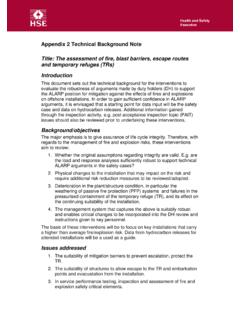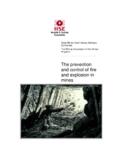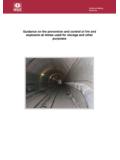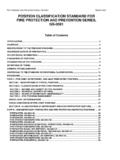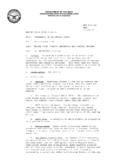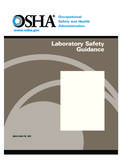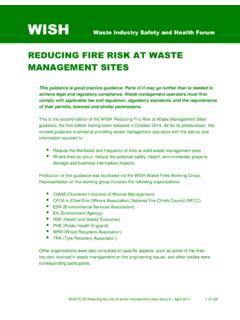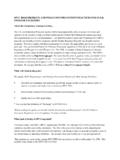Transcription of 152-RP-48 060202 changes accepted - Solent …
1 Ltd +44 (0)1561-378383 8-10 High Street Laurencekirk Scotland AB30 1AE UKOOA / HSE fire and explosion guidance Part 2: Avoidance and mitigation of fires FINAL DRAFT Main comment review completed Document number 152-RP-48 Revision Date Reason for Issue A 1 Mar 05 Initial build B 21 Jun. 05 All received material to date 0 3 July 05 Issued for comment to sponsors, authors and peer review 1 02 Feb 06 Issued following review of main comments 2 06 Feb 06 Issued for use 152-RP-48 Rev 02, Feb 2006 Page 2 of 261 Foreword This document has been prepared by limited by compiling contributions from a selection of industry experts in various aspects of fires on offshore installations. This document has been prepared by limited under a joint industry project sponsored by UKOOA and the UK HSE.
2 The production of the initial text was undertaken by a number of organizations and individuals, principally: David Galbraith and Ed Terry Steve Walker MSL Engineering Barbara Lowesmith Loughborough University Terry Roberts, Stefan Ledin and Stuart Jagger Health and Safety Laboratory Bassam Burgan Steel Construction Institute John Gregory Risk Management Decisions Theresa Roper Aker Kv rner Bob Brewerton Natabelle Technology Graham Dalzell TBS cubed Denis Krahn Mustang Associates This document is part of a series being produced by UKOOA and HSE on fires and explosions, the full series being: Part 0 Hazard management (formerly FEHM) Part 1 Avoidance and mitigation of explosions Part 2 Avoidance and mitigation of fires Part 3 Detailed design and assessment guidance 152-RP-48 Rev 02, Feb 2006 Page 3 of 261 Contents 1. Introduction 5 History .. 5 Objectives .. 6 fire and explosion hazard 7 Overview of the 8 2. fire hazard management philosophy 10 Overview.
3 10 Understanding the fire 13 Hazard management principles .. 24 Hazard management systems .. 25 Legislation, standards and guidance in the 28 Inherently safer 31 Risk 38 Risk reduction .. 41 Human 3. Fires on offshore installations 44 Introduction .. 44 fire types and scenarios .. 44 fire prevention methods .. 47 Gas and fire detection and control methods .. 50 Methods for mitigating the effects of fires .. 60 Performance 66 Methods and approaches to structural 69 Particular considerations for floating structures, storage and offloading systems .. 78 Particular considerations for mobile offshore units .. 82 Particular considerations for existing 90 Particular considerations for accommodation and other areas for personnel .. 95 4. Interaction with explosion hazard management 96 General .. 96 fire and explosion prevention methods .. 97 fire and explosion detection and control 98 fire and explosion mitigation 101 Combined fire and explosion 106 Safety conflicts.
4 108 fire and explosion 110 Decks .. 111 Feedback from explosion testing at Spadeadam .. 112 5. Derivation of fire loadings and heat transfer 113 Introduction .. 113 fire characteristics and combustion effects .. 113 fire and smoke 123 152-RP-48 Rev 02, Feb 2006 Page 4 of 261 Estimating fire and smoke loadings .. 127 Heat transfer .. 136 6. Response to fires 154 Properties of common materials in use 154 Effects of fire and nature of failures .. 156 Acceptance 164 Methods of assessment .. 166 Attachments and 172 Process 173 Personnel .. 180 7. Detailed design guidance for fire resistance 194 General .. 194 The design sequence minimising fire hazards throughout the design .. 195 Best practice for fire protection systems .. 207 Human factors man / machine interface .. 219 Industry & regulatory authority initiatives .. 222 8. References 225 Section 1 .. 225 Section 2 .. 225 Section 3 .. 225 Section 4 .. 225 Section 5.
5 225 Section 6 .. 225 Section 7 .. 225 Annex A Acronyms, abbreviations etc. 226 Annex B Glossary 227 Annex C Details on legislation, standards and guidance 247 Annex D Review of models 252 Annex E Checklists 261 152-RP-48 Rev 02, Feb 2006 Page 5 of 261 1. Introduction History Following the Piper Alpha disaster a large Joint Industry Project called Blast and fire Engineering for Topsides Structures (Phase 1) was carried out between May 1990 and July 1991. The main deliverable from this project was the Interim Guidance Notes (IGNs) [ ] and 26 background reports [ to ] written by the participants and published by the Steel Construction Institute (SCI) in November 1991. These background reports are available as free downloads from the HSE web site [ ]. The development of the Interim Guidance Notes was a major step forward which consolidated the then existing knowledge of fire and explosion hazards.
6 At about this time the fire and Blast Information Group (FABIG) was set up and has subsequently issued a number of Technical notes on specific aspects of fire and explosion engineering [ to ], of the eight published Technical Notes, five deal with fire hazard issues. The hazards, characteristics and physical properties of hydrocarbon jet fires were appraised in the Phase 1 reports of the Joint Industry Project on Blast and fire Engineering of Topside Structures (OTI 92 596/597/598) [ ]. The main source of detailed information on the characteristics of jet fires covered in the reports on the programme of jet- fire research was co-funded by the European Community. This programme studied single fuel natural gas and propane jet fires (Bennett et al, 1990) [ ]. A further project funded by the CEC, looked at the hazardous consequences of Jet fire Interactions with Vessels (JIVE), this project covers the modelling of jet fires, large scale natural gas/butane jet fires and taking vessels to failure in jet fires and some results of jet flame impingement trials are reported in OTO 2000 051 [ ].
7 Phase I of the JIP (OTI 92 596/597/598) [ , , ] also included a review of open hydrocarbon pool fire models. Three types of model (current at the time) were evaluated, semi-empirical proprietary models, field models ( CFD models) and integral models (falling between semi-empirical and field models). Compartment fire modelling looked at two types of code, zone models and field models. At that time, the zone models (typically used for modelling fires within buildings) encountered severe limitations in the modelling of large offshore compartment fires. Three further phases of the Blast and fire Engineering Project JIP were conducted from 1994 to 2001, Phase 2 [ ], Phase 3a and Phase 3b [ ] consisted mainly of experiments to define and determine explosion overpressure load characteristics under a range of conditions and to provide a basis against which load simulation software may be validated.
8 However, Phase 2 did produce notable gains in knowledge in the area of unconfined crude oil jet fires and confined jet fires (compartment fires). Two other separate but widely supported JIPs were also conducted around this period which focussed on offshore fire hazards. One studied the effectiveness of water deluge on jet and pool fires and the second JIP studied jet fires involving live crude containing dissolved gas and water. The Phase 2 JIP also focussed on horizontal free jet fires of stabilised light crude oil and mixtures of stabilised light crude oil with natural gas and the main findings are listed below. The free flame releases, of crude oil only, were not able to sustain a stable flame and one of the mixed fuel releases was also unstable. All the flames were particularly luminous compared with purely gaseous jet flames and generated large quantities of thick black smoke, mainly towards the tail of the flame.
9 All the flames were highly radiative, with maximum time averaged surface emissive powers (SEPs, heat radiated outwards per unit surface area of the flame) ranging between 200 kWm-2 to 400 kWm-2. 152-RP-48 Rev 02, Feb 2006 Page 6 of 261 The incident total heat fluxes (radiative and convective) measured on the pipe target were significantly higher for the mixed fuel tests than for the crude oil only tests, by a factor of two in many cases. Typical values were in the range 50 kWm-2 to 400 kWm-2. Phase 2 of the JIP included a fire model evaluation exercise. This considered three jet- fire scenarios, but no pool- fire scenarios. However it did generate high quality data that were considered suitable for future pool fire model evaluation. Other valuable work, mostly executed in Norway and following the probabilistic approach, has resulted in the NORSOK guidance documents [ , ]. Both references were among the source documents for Part 1 of this Guidance, it can be seen that the guidelines for risk and emergency preparedness will support emergency response for fire hazards as well.
10 Objectives The primary objective of this document is to offer guidance on practices and methodologies which can lead to a reduction in risk to life, the environment and the integrity of offshore facilities exposed to fire hazards. Risk is defined as the likelihood of a specified undesired event occurring within a specified period or resulting from specified circumstances. Preventative measures are the most effective means of minimising the probability of an event and its associated risk. The concepts of Inherently Safer Design or Inherent Safety are central to the approach described in this document both for modifications of existing structures and new designs. This document consolidates the R&D effort from 1988 to the present day, integrates fire type and scenario definition, fire loading and response development and provides a rational design approach to be used as a basis for design of new facilities and the assessment of existing installations.
